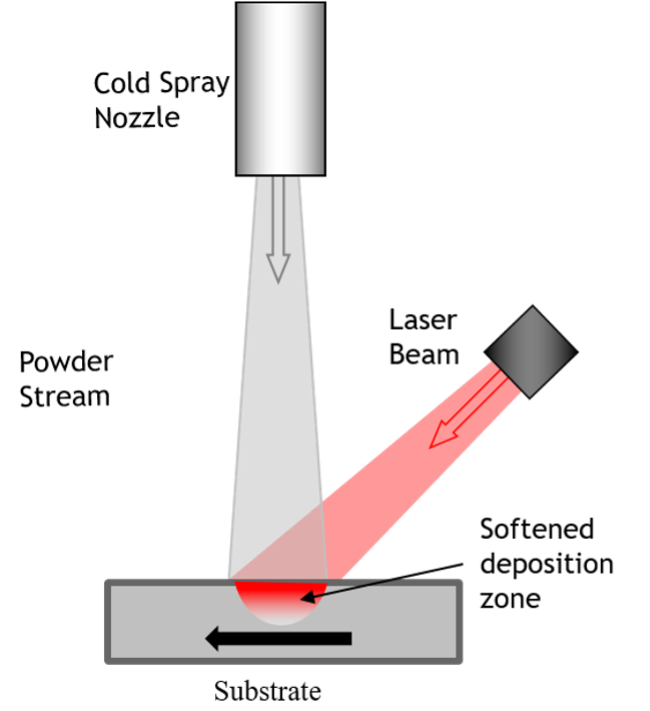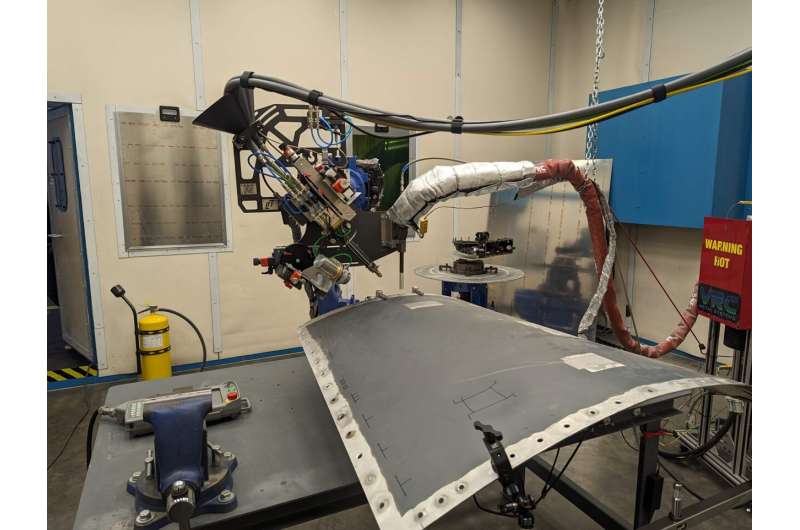The Centre for Industrial Photonics (CIP) at the Institute for Manufacturing (IfM) has developed a groundbreaking additive manufacturing technique, laser-assisted cold spray (LACS).
The potential applications for LACS are limitless and we are motivated to deliver a technology that can significantly aid in the transition to net zero, through both a more efficient, low-waste manufacturing technology and the doors it opens for sustainable product development.Professor Bill O’Neill
The process uses localised heating of a supersonic powder stream with a laser to deposit metals and cermets to build, coat or repair parts, overcoming the high-temperature and material limitations of comparable techniques such as thermal spraying.
The Centre for Industrial Photonics team has demonstrated the effectiveness of LACS in aerospace applications, where high-precision and localised material deposition are critical. This technique enables on-demand fabrication of high-quality coatings and component repairs, extending aircraft lifespan. Additionally, LACS reduces material waste and energy consumption compared to traditional methods, supporting the industry’s transition towards net-zero emissions.
Additive manufacturing
Traditional manufacturing techniques typically involve removing excess material from a solid block to achieve the desired shape using subtractive methods. In contrast, additive manufacturing builds structures layer by layer, commonly termed 3D printing. The LACS process can create parts from scratch or add coatings and features to existing components, proving particularly useful for high-performance coatings, critical component repairs and additive manufacturing in the aerospace, process, energy and biomedical industries.
This innovative manufacturing method offers several advantages over traditional techniques, including the rapid production of custom, complex parts with minimal material waste. It enables the integration of multiple materials to achieve enhanced properties, allowing components to be tailored to specific applications. Additionally, it eliminates the need for costly moulds or extensive machining, making it particularly valuable for industries requiring low-volume, high-precision parts. By adopting this approach, manufacturers can achieve greater design flexibility, efficiency and precision in production.
As of 2023, the United Kingdom holds approximately 7.6 % of the global additive manufacturing market, with an even smaller share in additive-based coating systems. The global additive manufacturing market is projected to grow significantly, reaching between $70 billion and $88 billion by 2030, depending on various market analyses. This anticipated growth underscores substantial opportunities for innovation and development within this rapidly expanding industry.
Laser-assisted cold spray
The Centre for Industrial Photonics (CIP) at the Institute for Manufacturing (IfM), under the leadership of Professor Bill O’Neill and his team of laser engineers and manufacturing experts, is pioneering advanced additive manufacturing methods using both cold spray and powder bed fusion.
“Cold spray is a technique for rapidly fusing powdered metals, cermets (composites of ceramic and metal) or polymers without melting them, which can then be used for building, coating or repairing parts. I first encountered cold spray while working at the University of Liverpool and set up my first facility dedicated to it there,” says Bill.
“At first, we concentrated on using nitrogen as a carrier gas for the powder. When working with high-strength materials such as titanium and aluminium alloys — commonly used in aerospace — we found that helium was essential for achieving optimal deposition. This is because helium, because of its lower molecular weight, enables higher particle velocities in cold spray, enhancing impact energy and improving adhesion to the substrate.”
The requirement for helium posed a significant challenge because of its cost, which is around £80 per minute of operation. Even state-of-the-art recycling efforts recovered only around 85% of the helium. Additionally, the equipment necessary for recycling greatly restricted the size of the parts that could be manufactured, as they had to fit within a size-limited chamber designed to capture the excess helium.
“Imagine trying to apply a coating to a section of aeroplane cladding,” says Dr Andrew Cockburn, Senior Research Associate in the CIP lab. “Being able to do that within the constraints of a helium-recycling system is just unrealistic. We needed to find a more practical solution for these high-strength materials, and that’s when we started investigating using lasers.”
To remove the barriers caused by helium, the team invented a process now known as “laser-assisted cold spray (LACS)”. LACS facilitates more efficient deposition of solid-state material powders by adding a laser to heat the deposition site locally (reducing the substrate yield stress), resulting in a stronger bond between the materials without the need for melting.

Illustration of the LACS process, showing the laser beam heating the powder deposition zone.
Beyond the reduction in cost from removing helium, LACS has some significant advantages over other cold spray methods:
- Enhanced adhesion and deposition efficiency. The localised laser preheating softens the substrate, improving particle bonding and deposition efficiency. This results in stronger coatings than conventional cold spray, and other thermal spray processes, especially for high-strength materials like titanium and refractory metals.
- Deposition occurs at a lower particle velocity, meaning the powder’s structure is retained in the coating/part. This is a significant advantage for materials with specialised properties that are easily damaged, such as nano-structured coatings and rare earth magnets.
- Improved material compatibility. LACS enables the deposition of harder and more challenging materials that typically have poor adhesion in standard cold spray. This includes cermets, refractory metals and oxidation-resistant alloys.
- Reduced residual stresses and porosity. The laser’s thermal input reduces residual stresses within the coating, leading to improved mechanical properties. It also minimises porosity, enhancing the structural integrity and durability of the deposited layer.
- Minimal thermal impact on substrate. Unlike traditional thermal spray methods, LACS keeps the substrate below melting temperature, avoiding phase transformations or distortion. This makes it ideal for heat-sensitive materials and applications where preserving base material properties is critical.
- It’s fast — coatings can be added at up to 10 kg per hour.
- Lower temperatures of the overall process. Laser assistance allows the process to operate at lower gas temperatures, for example 400–700 oC, compared to up to 1200 oC for cold spray, reducing power consumption and simplifying system design.
- Fine-tuning of coating properties by creating customised powders enables specialised characteristics such as magnetism, solid-state lubrication and enhanced wear resistance to be introduced into deposits. Grading composition provides local control of properties and allows the stresses at interfaces between dissimilar materials to be reduced.
“Developing a new generation of innovative manufacturing technology with advanced processing capabilities could significantly aid the transition to net zero,” explains Bill.
“The ability to customise the properties of the materials is a real game-changer and has a huge range of potential applications; examples are producing lightweight components for electric vehicles and aerospace, creating hydrogen storage systems, enhancing wind turbine maintenance, manufacturing energy-efficient batteries and fuel cell components, and developing advanced heat exchangers for industrial energy savings and catalyst coatings for carbon capture.”
LACS in practice — aerospace
Aparticular advantage of LACS is its ability to both build and repair custom parts, a capability that is acutely useful for aerospace. They require high-precision, high-strength and relatively low-volume manufacturing of typically complex parts. Using traditional manufacturing techniques, the most cost-effective solution is to manufacture all the parts necessary for a particular model at one time and store them in a warehouse until they are needed. This creates two main issues: storage is space-intensive and costly; and, once the parts are used, there simply are no more for repair. As a result, aircraft can become unusable, as there are no replacement parts to fix them — Concorde G-BBDG is a high-profile example before the model was ultimately retired in 2003.
LACS offers a sustainable, cost-effective and efficient option for repair, and, in more extreme cases, re-manufacture from a base part. Traditional repair techniques, such as welding, are unsuitable for high-performance applications, for example 6000 series aluminium. The heating needed to adhere the new and old material together impacts the strength and reliability of the repaired part.
Bill and his team have shown that the relatively low-temperature, localised laser heating used in LACS allows new material to be added without negative side effects. Furthermore, as with 3D printing, the LACS equipment has the potential to be programmed to build to a specified design from a computer model, allowing complex, digital designs to be quickly turned into tangible products.
“This is transformative for many industries, allowing custom parts to be created and repaired on demand in a short time frame, having low-cost, low-energy budget and efficient use of materials,” says Dr Martin Sparkes, Principal Research Associate in the CIP lab. “We are excited to work together with industry partners to realise the potential of this unique and impactful technology.”
Limitless potential
The next step for the CIP lab is to enhance the capability of LACS to “3D print” a shape. The team are exploring several avenues to achieve this goal, including mounting the part on a moving arm to allow it to be moved in 3D space and increasing the control over the direction of the powder stream to produce crisp, smooth edges.
Comparison of deposited surface for Net Shape Cold Spray Additive Manufacturing (NS-CSAM) and cold spray (CS), clearly showing the controlled deposition given by NS-CSAM.
“Currently, we have little control over the shape of deposition of the powder. This is not an issue for coatings but presents a significant restraint for part-building applications. Our next goal is to find a solution to this limitation, and we already have some very promising results,” says Bill.
“The potential applications for LACS are limitless and we are motivated to deliver a technology that can significantly aid in the transition to net zero, through both a more efficient, low-waste manufacturing technology and the doors it opens for sustainable product development.”
Find out more about LACS, the broader work of CIP and contact the team here.
This article was originally published at IfM insights on Medium.com blog hosting platform.


